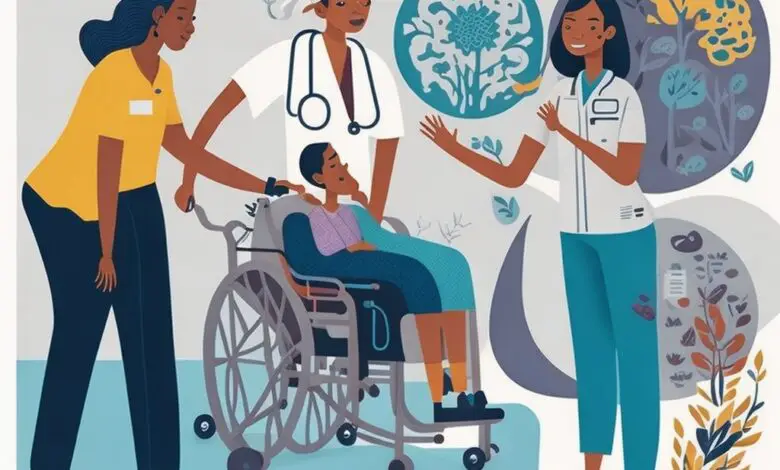The Role of Nurses in Rehabilitation Services

Introduction
Rehabilitation services sound like something straight from a medical textbook, doesn’t it? But it’s not as complex as it may seem. Imagine breaking a leg and needing a series of exercises to walk again. That’s rehabilitation. Now, who do you think is often at the heart of this recovery? You guessed it, the nurses.
In the world of healthcare, nurses are more than just a friendly face; they are the unsung heroes who often bear the responsibility of getting patients back on their feet. From physical therapy to emotional support, nurses play an essential and multifaceted role in rehabilitation services. This article aims to shine a light on these incredible professionals and show you just how vital they are in the process of healing.
Background and Context
History of Rehabilitation Nursing
Let’s take a walk down memory lane to understand how the field of rehabilitation nursing has evolved. It’s not something that popped up overnight. In fact, rehabilitation nursing has roots that reach back to the aftermath of World War I. As soldiers returned home with life-altering injuries, there was an urgent need for specialized care.
In the 20th century, the face of healthcare began to change, and so did the role of nurses. No longer were they simply bedside caregivers; they were educators, planners, and coordinators. Their influence spread across various fields, and rehabilitation was no exception.
Growing Need for Rehabilitation Services
In today’s fast-paced world, accidents and illnesses are unfortunately common. More and more people find themselves needing rehabilitation to get back to their daily lives. It’s not just about broken bones; it’s about recovery from strokes, surgeries, or even learning to live with chronic conditions.
This growing need has thrown a spotlight on the importance of rehabilitation services, especially in aging populations. Nurses, in turn, are stepping up to meet this challenge, becoming the very backbone of rehabilitation care.
Evolution of the Nursing Role in Rehabilitation
Nurses have come a long way, haven’t they? From simply following doctors’ orders to becoming key players in patient care, their role in rehabilitation has grown leaps and bounds. In many ways, nurses are the glue that holds the rehabilitation process together.
They assess, plan, and implement personalized care programs. They work hand-in-hand with doctors, therapists, and families. They are the compassionate voice that reassures and guides patients through a journey that can often be frightening and overwhelming.
The role of nurses in rehabilitation is a tapestry woven with care, dedication, and expertise. It’s an ever-evolving field that recognizes the unique human touch nurses bring to healthcare.
The Multidimensional Role of Nurses in Rehabilitation

Assessment and Planning
When it comes to rehabilitation, every patient is a unique puzzle, and nurses are the master puzzle-solvers. They start by understanding a patient’s medical history, disabilities, and individual needs. Sounds simple, right? But it’s anything but.
From that first meeting, nurses begin to assess the big picture. What are the patient’s goals? What hurdles must be overcome? They work closely with other healthcare professionals, and together, they sketch out a path toward recovery. This roadmap is tailored to the patient, aiming not just for healing but for returning to a full and meaningful life.
Implementation of Care
Here’s where the rubber meets the road. Nurses roll up their sleeves and get to work administering treatments, teaching patients exercises, and even providing that much-needed emotional support.
Think about it: rehabilitation can be a long and taxing journey. It’s like climbing a mountain, and nurses are the trusted guides, leading the way, offering encouragement, and even a helping hand when the path gets steep.
Medication management, wound care, educating the patient and their family – these are just a few of the countless tasks they handle with grace and skill.
Monitoring and Evaluation
The rehabilitation process isn’t a straight line; it’s full of twists and turns. Who’s there to navigate them? Nurses, of course! They continually monitor the patient’s progress, always ready to adapt and make changes.
Like skilled captains steering a ship through stormy seas, nurses evaluate the outcomes of treatments, adjust care plans, and keep a keen eye on the horizon. They celebrate the victories, no matter how small, and work diligently to overcome any setbacks.
Specialized Areas of Rehabilitation Nursing
Physical Rehabilitation
Physical disabilities can be a real roadblock, but nurses in physical rehabilitation help patients overcome these hurdles. Whether it’s a sports injury or a car accident, physical rehabilitation nurses use therapeutic interventions and exercises to get patients moving again.
These aren’t cookie-cutter solutions. Every exercise, every piece of equipment is chosen with care. Nurses often work with assistive devices, turning obstacles into stepping stones towards recovery.
Neurological Rehabilitation
Ever thought of the brain as a complex highway system? In cases of stroke, brain injuries, or spinal cord injuries, some of these roads might be closed. Neurological rehabilitation nurses are the traffic engineers, finding new routes and helping the brain rebuild.
Through cognitive therapy and the magic of neuroplasticity, they guide patients to regain lost functions. Working in tandem with other specialists, they forge a pathway that often leads to miraculous recoveries.
Geriatric Rehabilitation
Growing older is like turning the pages of a rich and complex book. But sometimes, aging comes with its challenges. Geriatric rehabilitation nurses specialize in this unique chapter of life. They understand the particular needs of older adults and focus on maintaining independence.
Whether it’s recovering from a fall or managing a chronic illness, geriatric rehabilitation nurses are the nurturing forces that keep the golden years shining bright.
Ethical Considerations
Patient Autonomy and Consent
In the world of rehabilitation, there’s a golden rule: the patient is in the driver’s seat. Nurses are there to guide, support, and assist, but they also respect the patient’s autonomy and decisions.
Consent isn’t just a one-time signature on a piece of paper. It’s a continuous dialogue where nurses ensure that the patient is always informed and comfortable with the care they’re receiving. It’s about building trust and honoring the dignity of those in their care.
Cultural Sensitivity
Imagine walking in someone else’s shoes. Nurses do this every day, meeting patients from diverse backgrounds and cultures. They’re like skilled diplomats, navigating cultural norms, beliefs, and traditions.
Being culturally sensitive means understanding that one size doesn’t fit all. It’s about personalizing care in a way that respects and honors individuality. Nurses in rehabilitation are often the bridges between medical practices and cultural values, ensuring that care is not just effective but also compassionate.
Privacy and Confidentiality
You wouldn’t share your deepest secrets with just anyone, would you? In rehabilitation, patients often share personal and sensitive information with their nurses. Maintaining privacy and confidentiality is more than just a legal obligation; it’s a sacred trust.
Nurses safeguard this trust like sentinels, ensuring that information is protected and shared only with those directly involved in the patient’s care. It’s this commitment to privacy that helps build a safe and open environment where healing can thrive.
Advocacy for Patient Rights
Speak up, stand tall, and be heard! Nurses are often the champions of patient rights. Whether it’s ensuring access to necessary resources or defending a patient’s choices, they’re the ones beating the drum.
Nurses understand that rehabilitation isn’t just about physical recovery; it’s about empowering patients to take control of their lives. Through advocacy, they amplify the patient’s voice, turning whispers into roars.
Collaboration and Interprofessional Relationships
Working with Doctors, Therapists, and Other Healthcare Staff
Nursing isn’t a solo act. It’s a symphony, where everyone plays a vital part. Nurses collaborate with doctors, therapists, social workers, and more. Together, they create a harmonious tune that guides the patient through the rehabilitation process.
This teamwork isn’t always easy. It’s like coordinating a dance where everyone has to move in rhythm. But through communication and shared goals, nurses help orchestrate a care plan that hits all the right notes.
Integrating Family and Community in Rehabilitation
Rehabilitation is like building a house. The patient is the foundation, but the family and community are the supporting walls. Nurses understand the importance of integrating these key players into the care process.
They educate, involve, and support not just the patient but those around them. By weaving the threads of family and community into the fabric of care, nurses create a tapestry that can withstand the stresses of illness and recovery.
Challenges in Rehabilitation Nursing
Emotional Demands
Let’s be real: rehabilitation nursing is emotionally taxing. Patients may face slow progress or even setbacks, leading to frustration and despair. Nurses are there through it all, offering a listening ear, a comforting word, and an uplifting smile.
But this emotional investment can take its toll. It’s like carrying a heavy backpack up a steep hill. Nurses must find ways to replenish their emotional reserves, making self-care an essential part of their professional lives.
Complex Care Coordination
Juggling many responsibilities at once? Nurses know that all too well. They coordinate care across various healthcare providers, manage complex treatment plans, and navigate intricate healthcare systems.
It’s like putting together a 1,000-piece puzzle without a picture on the box. But nurses, with their skill, patience, and determination, make it look like child’s play. Still, this complexity can be a challenge that demands continuous learning and adaptability.
Resource Limitations
Imagine trying to paint a masterpiece without all the necessary colors. Resource limitations in healthcare can make the rehabilitation process a bit like that. Whether it’s staffing shortages or inadequate facilities, nurses often have to do more with less.
Creativity becomes their secret weapon, turning obstacles into opportunities. They improvise, adapt, and overcome, but it’s no secret that this challenge can stretch them thin.
Opportunities in Rehabilitation Nursing
Advancements in Technology
The future is here, and it’s wearing a nurse’s cap! Technological advancements are revolutionizing rehabilitation services, offering new tools and techniques. From virtual reality to robotic aids, nurses are embracing these innovations.
It’s like having a brand-new toolkit, opening doors to more efficient and effective care. These opportunities not only enhance patient outcomes but make the nursing profession even more exciting and rewarding.
Growing Field and Career Advancement
The rehabilitation sector is expanding, and so are the opportunities for nurses. Specializations, certifications, and advanced roles are blossoming like never before.
Want to climb the career ladder? In rehabilitation nursing, the sky’s the limit. Whether it’s leadership roles or research opportunities, nurses can carve out a path that matches their passion and skills.
Education and Training
Required Qualifications and Certifications
You wouldn’t hand over your car keys to just anyone, would you? Similarly, rehabilitation nursing requires specific qualifications and certifications. From a bachelor’s degree in nursing to specialized training in rehabilitation, the journey to becoming a rehabilitation nurse is filled with learning and growth.
Certifications not only validate a nurse’s skills but also offer a badge of honor, reflecting their dedication to excellence.
Ongoing Education and Professional Development
The world of healthcare is like a river, always flowing, always changing. Nurses must ride these currents through continuous education and professional development.
From workshops to seminars, nurses invest in themselves, keeping their knowledge fresh and their skills sharp. It’s a commitment to lifelong learning that ensures they remain at the forefront of patient care.
Conclusion
The Heart and Soul of Rehabilitation
Nursing in the rehabilitation sector is far more than just a job; it’s a calling. It’s about bringing hope to those facing some of the most challenging times in their lives. It’s about being a guiding star, a steady hand, and sometimes, a shoulder to cry on.
Imagine being the one to help someone walk again or return to the hobbies they love. It’s more than science; it’s art, empathy, and pure human connection. Nurses in rehabilitation are the unsung heroes, working behind the scenes to make miracles happen every day.
A Symphony of Skills
From physical to neurological rehabilitation, from ethical considerations to education and training, the role of nurses in rehabilitation is multifaceted. It’s like watching a skilled conductor leading an orchestra, coordinating different instruments to create a harmonious melody.
Each part of their role is essential, each skill vital to the overall success of the patient’s journey. The nuances, the challenges, the opportunities – they all play together in a symphony of healing and empowerment.
Embracing the Future
Rehabilitation nursing is an ever-evolving field, embracing the advancements of technology, meeting new challenges head-on, and opening doors to exciting opportunities. It’s like standing at the threshold of a new era, ready to step into a future filled with promise and innovation.
The passion for continuous learning, the hunger for growth, the commitment to excellence – these are the hallmarks of rehabilitation nurses. They stand as a testament to the resilience, creativity, and compassion of the nursing profession.
A Tribute to Rehabilitation Nurses
So here’s to the nurses in rehabilitation services, the quiet warriors, the compassionate healers, the tireless advocates. Their work often goes unnoticed, but the ripples they create touch countless lives.
They are the bridge between illness and wellness, despair and hope, dependence and independence. They are the heartbeat of rehabilitation, and their stories deserve to be told, celebrated, and cherished.
In the end, the role of nurses in rehabilitation services isn’t just about medical care. It’s a deeply human endeavor, a dance between science and soul. Whether you’re a patient, a family member, or simply curious about this field, we hope this article has opened a window into a world filled with dedication, love, and extraordinary skill.
From the assessment to the education, from the ethics to the emotions, the layers of rehabilitation nursing have been peeled back. The journey is complete, but the impressions linger. May they inspire respect, gratitude, and understanding of this invaluable aspect of healthcare.
Thank you for coming along on this exploration. The world of rehabilitation nursing is richer, more complex, and more beautiful than most realize, and now, perhaps, you see it too.




